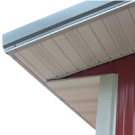Saving Money When Venting An Attic?
While some of you may think I have been doing post frame buildings since dinosaurs roamed our planet, I can assure you this is not true. Now my youngest son, when he was pre-school aged, did ask me (in all seriousness) what was it like watching space aliens build Egypt’s pyramids!
When reader DOMINIC in FESTUS wrote his question to me, it got me thinking about when I first had a client ask for a building with insulation at ceiling level. While I truthfully do not remember, in my first 6000 or so post frame buildings (we are talking 1980s here) I doubt there were more than a handful.
Fast forwarding to today’s modern fully engineered post frame buildings and nearly every building – garage, shop, barndominium, etc., is going to be climate controlled to some extent and most of these have enclosed attic spaces with insulation to be placed at ceiling level.
Here is DOMINIC’s question:
“I will be building a 30×40 pole barn soon. I plan on putting a ceiling in with insulation. My question is on attic venting. It seems best practice is to use a ridge vent with vented soffits but are gable vents alone sufficient? It would be cheaper for me to just do gable vents.”
 Your best practice is to have even airflow from eave intakes to ridge exhausts. If your building will have sidewall overhangs, you might as well take advantage of this. You COULD (as an alternative) utilize gable vents. Provided at least half of your gable venting is located in the upper half of the attic, you can get by with as little as 576 square inches of NFVA (Net Free Ventilation Area). To achieve this would require (3) three 20″ x 30″ gable vents in each endwall. This could prove unsightly, difficult to install and is unlikely to result in being less of an investment than ridge vents. NOTE: a 20″ x 30″ gable vent provides roughly 106 square inches of NFVA (not 20″ x 30″ for 600″).
Your best practice is to have even airflow from eave intakes to ridge exhausts. If your building will have sidewall overhangs, you might as well take advantage of this. You COULD (as an alternative) utilize gable vents. Provided at least half of your gable venting is located in the upper half of the attic, you can get by with as little as 576 square inches of NFVA (Net Free Ventilation Area). To achieve this would require (3) three 20″ x 30″ gable vents in each endwall. This could prove unsightly, difficult to install and is unlikely to result in being less of an investment than ridge vents. NOTE: a 20″ x 30″ gable vent provides roughly 106 square inches of NFVA (not 20″ x 30″ for 600″).
Of course, me being me, I had to snoop our records to see if he had requested a quote from us – and indeed he had…..
In looking over your quote from us, you may also want to consider increasing your overhead door width from 14′ to 16 (or even 18′) as you cannot safely get two vehicles side-by-side through a 14 foot wide door. For sake of resale value, with a 14 foot door it will appraise as a single car garage, wider doors will nearly double your appraised value as it is a two-car garage then.






